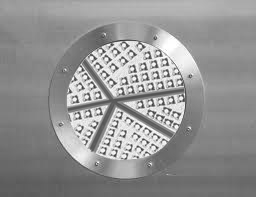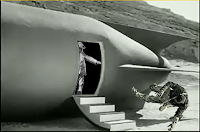Chapter 6– My
Interview With The Mayor
The Professor and I were ushered into the building, while
our guards were asked to wait outside. I was assured that there was nothing to
worry about, so we proceeded into the City Hall. The first room was a reception
area where we signed in and stated the purpose of our visit. We then followed
the guard down the corridor to the Mayor’s office.
The office filled the entire floor of the tower (as had the reception room), with the Mayor’s desk on the right hand wall as we entered the room. The room was rather Spartan, with only the Mayor’s desk and a few chairs. There was no artwork or symbols of the authority to be seen. All in all, it was a depressing space.
As we approached the Mayor’s desk, he stood up and Introduced himself. “Good day Mr. Roosevelt, I
am Reytik of Ceraunius. It is a pleasure to make your acquaintance.”, he said.
His command of the English took me aback. I quickly recovered and replied, “It is my pleasure to meet you Mr. Reytik.”
 I continued, “As you are aware, I am in command of the
United States Army station here. As such, I feel it is my responsibility to
learn as much about our situation here in the city and the local environs. So,
whatever information you can give me would be most helpful.”
I continued, “As you are aware, I am in command of the
United States Army station here. As such, I feel it is my responsibility to
learn as much about our situation here in the city and the local environs. So,
whatever information you can give me would be most helpful.”Reytik replied, “Well, Mr. Roosevelt, the situation here in Ceraunius is, as you say, right as rain. Your men have behaved very well, so far as conquerors go. The civilian population have hardly taken notice.”
“But, in some aspect, not all is, ‘right as rain’?”, I said.
“Well, there will always be some, professional jealously, between your soldiers and mine. However, the townspeople of Ceraunius are not your biggest problem. They know the power of your spaceships that utterly destroyed our previous overlords. No, I think they will be quite passive for a long while. Your real problem will be with the citizens of the towns further down the canals and the wildmen of the desert regions. They know nothing of your weapons or your motives so they will not fear you. Also, their customs in dealing with outsiders are very strict and rather unique. It takes a skilled negotiator just to prevent open hostilities and an exceptional one to gain tangible results. In fact, it would not surprise me in the least if, sooner rather than later, they test your metal with a skirmish or two with your patrols.”, Reytik said.
“Mr. Reytik,” I said, “I am sure we will be able to deal appropriately with the rural communities when the time comes, but I denote a bit of anxiety in your comments. You have referred to the United States of America as conquerors and overlords, but nothing could be further from the truth. America believes in self-government for a peoples and we are here to help you and your people to develop a sustainable self government.”
“Well, since you are only here to help us,” Reytik said, “I am sure that we will all get along famously.”
“Indeed.”, I said unconvinced. I knew that my words would not convince Reytik. It would take action to prove our motives. However, I needed Reytik to keep things under control in Ceraunius long enough for our American ideas of government to catch hold and take root. Since it would be another 3 months before the remainder of my three companies of troops and advisors arrived, so I would have to be careful so as not to incite trouble until I had the force to back it up.
I finished my interview with the Mayor and headed back to our base. As we walked back to the post, I asked Professor Edgren his opinion of Reytik and the state of affairs in Ceraunius. He said, “I do not think that Reytik has any real concept of what the American form of government is, nor do any of the “civilized” people of the planet. For millennia these people have only served the whims of their masters and even after those masters began to disappear, they were replaced by new ones.
“Who were or are these new masters?” I asked.
“It is my understanding that the original overlords of Mars were the Nagi-Fej. They came here eons ago and enslaved the population. At that time, populations of these tyrants occupied every city-state. This was the status-quo for many generations, until some sort of plague attacked the Nagi-Fej. As there population dwindled, they congregated to the city-states of Alba and Cophen. As the Nagi-Fej fled the outlying cities, their Martian go betweens took over as defacto rulers.”
“This maintained the status quo in the major cities and the neighboring regions, but it left the outlying towns to their own devices. On the fringes, a sort of feudal system evolved, again with the higher ranking Martians taking the part of the Baron. So, the towns further down the canals have a greater autonomy than those closer to the cities at the canal junctions.”
“Then there are the nomadic desert tribes. These are made up of the bands of slaves that have escaped through the ages. One could compare them to the Mongol tribes or the North American Indian. They eke out a meager existence following the herd animals that live in the desert and marginal areas.”
“The society, here at least, seems remarkably developed for one that so recently lost its power base. How has this happened?” I asked.
“I appears time is measured differently for the Martians, the Nagi-Fej, and us. The Nagi-Fej had extremely long lifespans and were slow to reproduce. So, what would be a crisis situation for them could have been going on for hundreds or thousands of Earth years. Indeed, the city-states furthest from the Cophen Exclusion Zone may have been free from the Nagi-Fej since Roman times on Earth or even earlier. The Martians lifespan is also greater than that of Earthmen, though nothing near the length of the Nagi-Fej. Their lifespan, the length of a Martian year, and their association with the Nagi-Fej are all factors that have modified the Martian concept of time.” Professor Edgren replied.
“So, I assume that because Ceraunius is so near the Cophen Exclusion Zone, their society shows a greater degree of Nagi-Fej influence than in other states?” I said.
“Indeed,” Professor Edgren responded, “While contact with the Nagi-Fej was diminishing over the
last seven hundred to eight hundred years, Ceraunius has been truly independent only for the last one hundred years or so.”
My meeting with Mayor Reytik and this brief Martian history lesson helped me to develop my plans for the future. Next, it was time to meet with my officers and get their perspective on the relationship between our people and the native population.









